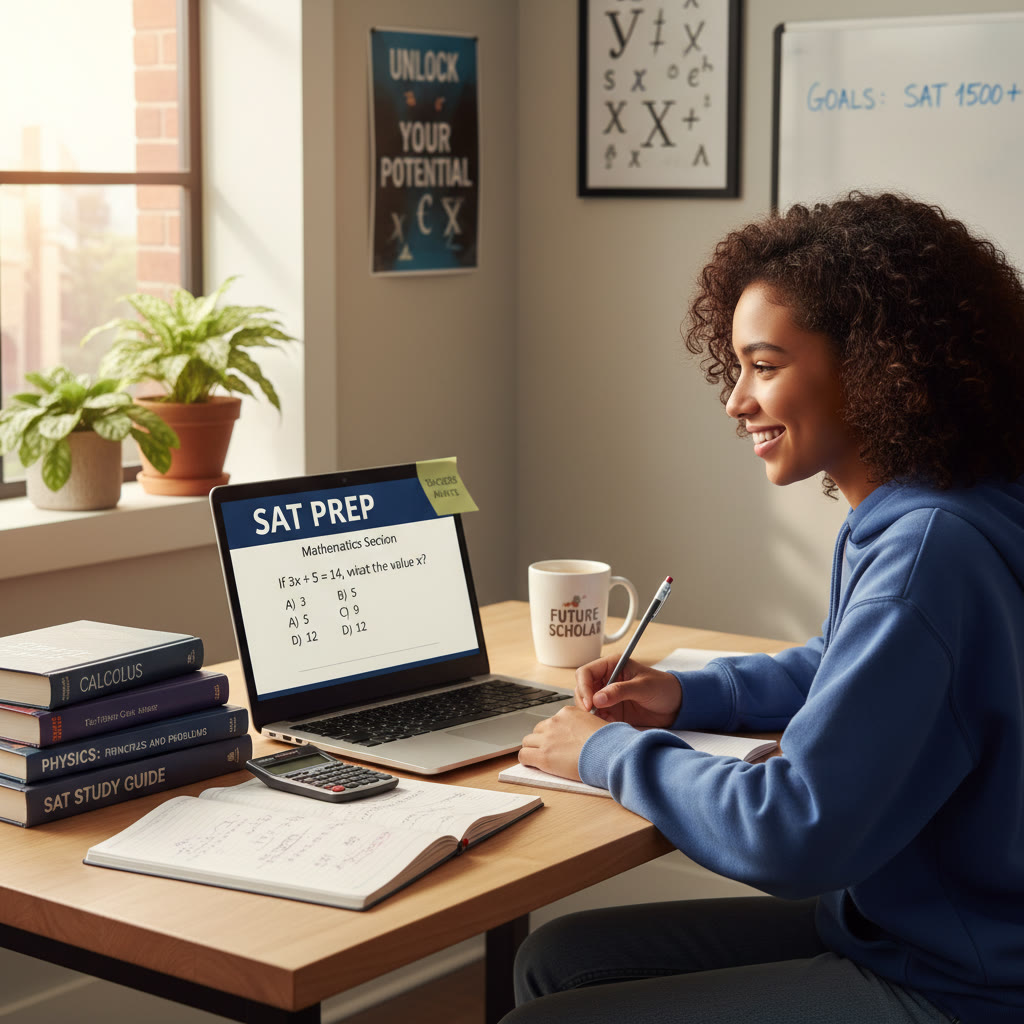Introduction: Why the SAT Still Matters for Caltech Applicants
Applying to the California Institute of Technology (Caltech) feels different from applying to most other schools. It’s small, intensely focused on science and engineering, and looks for students who love solving hard problems. For many applicants and families, the question is simple: do SAT scores still matter—and if so, how should you prepare?
This guide walks you, step by step, through the current landscape of SAT expectations for Caltech applicants, practical testing strategies for the Digital SAT, real-world examples of planning and timelines, and what a targeted approach—like Sparkl’s personalized tutoring—can add to your journey. Think of this as a friendly conversation that helps demystify a crucial part of the Caltech application puzzle.

What Caltech Looks For: Beyond Numbers
Caltech’s admissions philosophy centers on academic excellence, especially in math and science, intellectual curiosity, and the ability to contribute to a collaborative research culture. While grades, recommendations, extracurriculars, and essays all matter, standardized test scores have historically been a compact signal of academic readiness—particularly for a school whose curriculum is heavy on quantitative problem solving.
In short: a strong SAT score can help your application speak the language Caltech understands, but it is not the only language. You still need compelling coursework, strong letters of recommendation (particularly from STEM teachers), and examples of intellectual curiosity in your activities and essays.
The Role of the SAT in the Caltech Application
- Benchmark for academic readiness—especially in math and evidence-based reading/writing.
- Useful for placement or contextual comparison against a global applicant pool.
- One piece of a holistic review that values depth of study, research experience, and problem-solving ability.
Digital SAT: What’s New and How to Adapt
The SAT has transitioned to a digital format, which changes the test-taking experience but not the core skills being assessed. The Digital SAT is shorter, adaptive by section, and often feels faster-paced than the paper test. For Caltech hopefuls—who will typically aim for very high scores—mastering efficient digital test strategies is critical.
Key Differences to Practice For
- Adaptive sections: performance in the first module influences the difficulty of the second; strong early performance can unlock higher scoring potential.
- Shorter timing windows—practice under timed, digital conditions so pacing becomes second nature.
- Tools and format: get comfortable with on-screen calculators, highlighting tools, and navigating questions in a digital interface.
Target Scores: What Counts as Competitive for Caltech
Caltech’s admitted students cluster at the very high end of the score spectrum. Because the school is highly selective and STEM-focused, aiming for excellence in the math portion is especially important. Below is a practical target table to help you set goals depending on where you are now.
| Applicant Profile | Digital SAT Total Target | Math Emphasis | How to Use This Target |
|---|---|---|---|
| Reach Applicant | 1550–1600 | Math 780–800 | Aim here if you have perfect or near-perfect coursework and exceptional research/ECs. |
| Competitive Applicant | 1500–1550 | Math 760–780 | Strong GPA + advanced STEM classes; test shows quantitative strength. |
| Solid Applicant | 1450–1500 | Math 740–760 | Good GPA, strong teacher recs; consider retaking to push higher if possible. |
Note: these targets are directional. Caltech reviews applications holistically. If you have extraordinary research experience, publications, or mentorships with professors, lower test scores can sometimes be balanced—but high SAT math scores are a clear advantage.
Creating a Practical Testing Timeline
A clear timeline turns anxiety into action. Here’s a sample plan that balances schoolwork, SAT prep, and application deadlines. Adjust based on whether you’re a junior or senior.
Junior Year (Spring–Summer)
- Take a diagnostic Digital SAT under realistic conditions.
- Create a targeted study plan focused on weak areas—especially math problem types you miss.
- Schedule an official Digital SAT for fall of senior year (or earlier if you want multiple attempts).
Senior Year (Fall–Winter)
- Take the test early enough to have time for one or two retakes before application deadlines.
- Use score reports to refine preparation; focus on high-yield practice and timing drills.
- Balance testing with application writing, teacher rec letters, and final coursework.
How to Prepare: Strategy, Skills, and Study Materials
Preparation is not about more hours alone; it’s about smarter hours. For a STEM-focused school like Caltech, depth matters: understanding why an answer is right and how to solve problems efficiently beats blind repetition.
Core Preparation Pillars
- Foundational content review: algebra, geometry, precalculus, and core problem-solving techniques.
- Targeted practice: focus on the specific item types you miss, with time-pressure simulations.
- Mock digital test sessions: build comfort with the adaptive format and tools.
- Analytical reading and data interpretation: crucial for evidence-based reading and real-world STEM contexts.
Study Tools That Work
- Official practice tests in digital format—simulate real test conditions.
- Khan Academy-style practice and targeted problem sets for persistent weak spots.
- One-on-one tutoring for customized problem diagnosis and pacing strategies—Sparkl’s personalized tutoring can provide 1-on-1 guidance, tailored study plans, expert tutors, and AI-driven insights to focus practice efficiently.
Smart Practice: Quality Over Quantity
When you practice, keep a running error log. Track the type of mistake (conceptual, careless, time-management), the content area, and the fix. This transforms practice tests from score-checks into learning tools.
Weekly Practice Routine Example
- 3 timed section sessions under digital conditions (focus on pacing).
- 1 full-length digital practice test every 2–3 weeks.
- Daily short drills: 15–30 minutes targeting weakest skill.
- Weekly review with a tutor or study partner to discuss errors and strategies.
Essays, Recommendations, and STEM Experiences: The Parts That Make Scores Shine
High test scores show readiness. But Caltech also wants evidence of curiosity and the ability to thrive in research-style learning. Here’s how to combine test excellence with compelling application elements.
Essays
- Use essays to show how you think like a scientist—describe a problem you loved solving, the process you used, what failed, and what you learned.
- Avoid generic statements; concrete examples of research projects, independent study, or competitions carry weight.
Recommendations
- Strong letters from math or science teachers who can speak to your analytical work, lab skills, or project persistence.
- Provide recommenders with a one-page summary of your projects and goals to help them write detailed, specific letters.
Research and Projects
- Even small research roles or long-term independent projects matter: quality beats quantity.
- Document your process—research notes, results, and what you’d do next—so you can discuss it in essays and interviews.
Realistic Scenarios: Examples and Comparisons
Here are three hypothetical applicants to illustrate how SAT performance fits into the whole picture.
| Applicant | SAT Total | GPA & Courses | STEM Experience | Outcome Potential |
|---|---|---|---|---|
| Deep-Research Dana | 1500 | 4.0 with multiple AP/IB math & physics | Published research & lab internship | Highly competitive—scores plus research make a strong case |
| Brilliant-but-Balanced Ben | 1560 | 3.9 honors & advanced STEM classes | Math & robotics team leader, national contest finalist | Very competitive—score and leadership in STEM are compelling |
| Late-Bloomer Lia | 1450 | Rising GPA with senior-year challenging coursework | Summer research and strong rec letters | Possible—would benefit from a retake to improve math score |
Test-Optional? What That Means for Caltech Applicants
Some institutions have moved to test-optional policies. For Caltech applicants, the practical reality is this: if your SAT reflects your academic strengths—especially in math—submit it. If your testing record is weak but you have extraordinary evidence of scientific achievement, the application can still be strong without it. Be strategic: the presence of a strong math score typically strengthens an application to a math- and science-heavy school like Caltech.
Common Questions Families Ask
How many times should my student take the SAT?
Most students benefit from 1–3 attempts. Take an early diagnostic, then 1–2 official administrations spaced to allow focused improvement. Avoid over-testing close to application deadlines—quality of preparation matters more than frequency.
Should I focus only on math?
Prioritize math, but don’t neglect evidence-based reading and writing (ERW). Caltech values clear communication and the ability to interpret scientific passages and data. A balanced high score shows rigorous thinking and attention to detail.
Does Sparkl tutoring actually help?
Personalized tutoring can accelerate progress by targeting the precise skills you need—filling content gaps, sharpening timing strategies, and building test-taking confidence. For many students, tailored plans and expert feedback from a 1-on-1 tutor reduce wasted practice and produce meaningful score gains. Sparkl’s AI-driven insights, when available, can add precision to a tutor’s plan and track progress efficiently.
Final Checklist: Ready to Submit Your Scores?
- Do my scores reflect my strongest academic abilities—especially in math?
- Have I balanced testing with strong coursework, recommendations, and a research narrative?
- Have I scheduled a retake early enough to improve if needed?
- Have I practiced thoroughly under digital, timed conditions?
- Do my essays and activities showcase scientific curiosity and problem-solving?
Closing Thoughts: A Confident, Calm Approach
Applying to Caltech is a marathon, not a sprint. The Digital SAT is an important checkpoint, but it’s only one of the ways you tell your story. Aim high on the math section, practice smart under digital conditions, and pair your score goals with real research, strong teacher recommendations, and essays that reveal how you think.
If you or your student could benefit from focused, individualized support, consider adding targeted tutoring to your plan. One-on-one guidance—combined with an AI-driven study plan—can transform weeks of unfocused study into measurable improvement. Resources like Sparkl offer precisely that: tailored study plans, expert tutors, and analytical insights to make every practice hour count.
Above all, keep curiosity at the center. Caltech looks for students who love learning for the sake of discovery. Let your test scores reflect that love, and let your application show how you’ll contribute to Caltech’s vibrant community of problem solvers.

Quick Resources: What to Do Next
- Take one official digital practice test this week under timed conditions.
- Set a realistic score target using the tables above and plan a test date.
- Book a short consultation with a trusted tutor to create a 6–8 week study plan—tailored, one-on-one help can make a big difference.
- Start drafting one application essay focused on a research or problem-solving experience; use it to clarify your narrative.
Good luck—approach this process with curiosity, steady preparation, and confidence. Caltech is looking for thinkers and doers; your test scores are one way to show the world the thinker you are.
















No Comments
Leave a comment Cancel